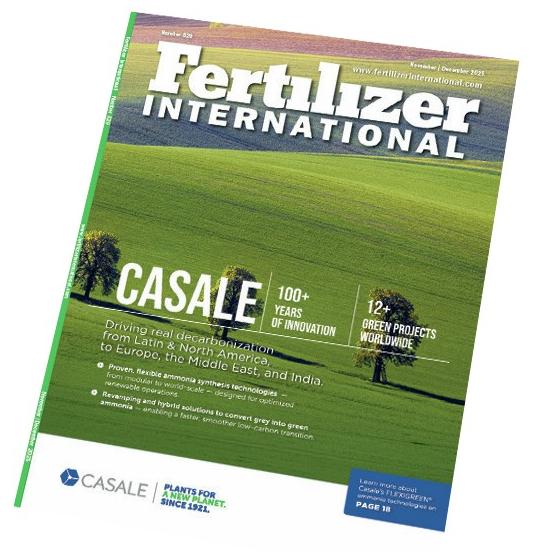Nitrogen+Syngas 369 Jan-Feb 2021

31 January 2021
Towards a sustainable nitrogen fertilizer industry: Part 1: Nitrogen use
ENVIRONMENT
Towards a sustainable nitrogen fertilizer industry: Part 1: Nitrogen use
Part 1 of a two part look at a potential sustainable future for the nitrogen industry, looking at sustainable nitrogen management and nutrient use efficiency.
The development and use of nitrogen fertilizer during the 20th century has been one of the great success stories of scientific development. Born out of fears of running out of mined nitrate sources during the late 19th century, particularly Chilean potassium nitrate deposits, which represented most artificial nitrogen applications at the time, the Haber-Bosch process has moved ammonia production from a 3 litres/day laboratory-scale experiment in 1909 to a 180 million t/a industry today. In the process, it has been responsible for a ‘green revolution’ in agricultural output which has allowed the world to move to a population of 7.7 billion without mass starvation. About 3.5 billion of these could not be fed without the use of artificial nitrogen fertilizers.
However, at the same time, this huge benefit has not come without some significant drawbacks. Synthetic ammonia production is a highly energy-intensive process, and the partial oxidation of fossil fuels to generate syngas produces on average 2.9 tonnes of CO2 emissions per tonne of ammonia. This makes the ammonia industry alone responsible for 520 million t/a of CO2 emissions, or just over 1% of the global total. We will deal with ways of reducing this figure in the next issue. At the same time, over-application of nitrogen fertilizers leads to release of nitrous oxides into the air and nitrates into water, the former adding to greenhouse gas emissions, and the latter causing rapid growth of algae (eutrophication) which deplete the oxygen content of water, leading to the death of fauna. At the extremes, this can lead to large scale aquatic ‘dead zones’ such as appear seasonally in the Gulf of Mexico and Baltic Sea due to run-offs from major rivers.
With the global population projected to rise to 9.8 billion by 2050, and the amount of arable land limited at roughly its current level, it is projected that another 60% increase in agricultural productivity may be required over the next 30 years. Fertilizer will no doubt play a part in this, but that means that unless the way that it is used changes, the problems will merely get worse.
UN resolution
Efforts to tackle this issue have been gradually moving up the political agenda over the past few decades, mainly via local or national regulations or industry-led voluntary schemes and best practice promulgation. In March 2019, they made it to the United Nations Environmental Assembly (UNEA), when delegates adopted a resolution calling for “a coordinated and collaborative approach to sustainable nitrogen management”. The resolution recognised “the multiple pollution threats resulting from anthropogenic reactive nitrogen, with adverse effects on the terrestrial, freshwater and marine environments and contributing to air pollution and greenhouse gas emissions”, and highlighted ways to better manage nitrogen.

The resolution supported exploring options for better management of the global nitrogen cycle to achieve sustainable development goals, including through the “sharing of assessment methodologies, relevant best practices and guidance documents and emerging technologies for recovery and recycling of nitrogen and other such nutrients.”
Its suggested options for better nitrogen management included: consideration of an intergovernmental coordination mechanism on nitrogen policies based on existing networks and platforms; ensuring coordinated management of relevant datasets relating to the environmental, food and health benefits of possible goals for improved nitrogen management; promotion of appropriate training and capacity building for policymakers and practitioners for developing widespread understanding and awareness of the nitrogen cycling and opportunities for action; and supporting member states with sharing and making available existing information and knowledge on developing an evidence-based approach to nitrogen management.
Nutrient stewardship
One of the key ways in which eutrophication and other issues can be tackled is by more efficient use of fertilizer. Globally, agricultural soils received an average total of 73 kgN per hectare per year. Of this, 61% came from fertilizer and manure, 10% from atmospheric deposition, and 29% from natural nitrogen fixation. But around half of the nitrogen applied to fields is not taken up by plants. Nutrient use efficiency can vary widely. For example, in Eastern China it is around 33%, whereas in the United States it can be 65%, and 61% in Western Europe. Losses to the atmosphere from ammonia volatilisation range from 17% in Europe and the US to 22% in China.
Using nutrient more efficiently has led to the concept of nutrient stewardship, developed by the International Fertilizer Industry Association (IFA) in conjunction with regional industry bodies including The Fertilizer Institute (TFI) in the US, Fertilizers Canada, Fertilizers Europe and the (now sadly defunct) International Plant Nutrition Institute. This in turn has led to the ‘4R’ initiative, aimed at getting farmers to apply the: Right fertilizer source, at the Right rate, at the Right time and in the Right place. A key concept is balanced nutrition, so that a lack of one nutrient, whether potash, phosphate, sulphur or micronutrients, does not prevent the plant from taking up nitrogen during its growth.
This forms part of fertilizer best management practices (FBMPs) which are actively promoted by the above organisations, developed through research and verified and continuously adapted in the fields, to manage the flow of nutrients in the course of producing affordable and healthy food in a sustainable manner.
Other FMBPs include site-specific nutrient management (SSNM), i.e. supplying plants with nutrients to optimally match their inherent spatial and temporal needs for nutrients; integrated plant nutrient management (IPNM) – applying available on-farm organic fertilizers to crops and supplementing them with mineral fertilizers; microdosing – applying small quantities of fertilizers, either during planting or 3-4 weeks after plant emergence; and fertigation – combining fertilizers with irrigation water.
As part of their outreach to global farmers, IFA and the World Farmers’ Organization (WFO) have produced a nutrient management handbook; a 25-page manual to help farmers achieve the goals of boosting productivity, achieving higher resilience and reducing greenhouse gas emissions.

Other initiatives
In November 2019, IFA instigated a new Scientific Panel on Responsible Plant Nutrition to meet the growing need for scientific research and expertise to further improve nutrient stewardship, in line with the outcomes of its IFA2030 strategic review. Composed of prominent plant nutrition experts from leading research organizations around the world, the Scientific Panel’s mission is to advance sustainable plant nutrition as it plays a key role in solving the challenges facing agricultural systems around the world by improving agricultural productivity and soil health while minimizing nutrient losses to the environment.
Improving NUE worldwide
In May last year IFA reported4 on progress in improving nutrient use efficiency (NUE) worldwide. Figure 1, abstracted from that report, shows the general trend in NUE trajectory observed in many countries, where consumption generally increases much faster than removal by crops and NUE drops rapidly. A turning point is reached once medium to high yields are attained, when farmers, policymakers, scientists and other stakeholders prioritise the improvement of NUE, after which surpluses stabilize or decrease owing to access to improved knowledge, inputs and technologies, finally approaching a theoretical limit in nutrient use efficiency.
Looking at the way that NUE had changed from the 1960s to the 2010s in six countries; Brazil, the US, Denmark, China, India and Nigeria, the report concluded that:
- too high and too low output/input ratios (NUE) levels are equally unsustainable;
- countries typically follow the U-shape NUE trend seen in Figure 1;
- NUE must be interpreted within the context of crop production systems;
- countries with a large share of their area planted to leguminous crops have a higher NUE while countries with a high proportion of less N use efficient crops (e.g. fruits and vegetables) have a lower NUE;
- countries where farmers use improved crop varieties, irrigation, fertilizer best management practices and technology (e.g. precision farming) have a higher NUE;
- countries where the fertilizer price is heavily subsidized (eg India) have a lower NUE;
- countries with high livestock production density (i.e. higher percentage of total inputs as manure N) have a lower NUE;
- Sub-Saharan African countries (and countries with similar low fertilizer application rates and low crop yields) can learn from experiences elsewhere and potentially avoid the U-shape trend.
- empirical evidence suggests that a combination of mineral fertilizer and organic fertilizer seems most promising for sequestering soil carbon in agricultural soils.
The report recommended adopting and implementing FBMPs tailored to site- and crop-specific conditions to enhance NUE and reduce losses to the environment while increasing yields and, in conjunction with the 4R message described above, that the fertilizer industry advance innovative products and technologies that enable further improvements in NUE. It also encouraged policymakers to take into consideration their countries’ specificities in terms of soils, crops and climate, and to tailor their plant nutrient recommendations according to these.
It also noted that precision agriculture, aided by technology, has the potential to further increase productivity while reducing greenhouse gas emissions, steering agricultural systems towards a sustainable, input-optimised model. The fertilizer industry and its research partners have developed several precision agriculture solutions, including mobile applications that allow farmers to send pictures of their crops and receive tailored fertilizer recommendations; hand-held sensors can measure the N status of crops; water sensors can assess the water requirement of plants by measuring pressure on leaves; and even simple tools like a leaf colour chart can guide farmers with their application of nitrogen fertilizer based on leaf greenness. An important challenge for the implementation of fertilizer BMPs is reaching out to the world’s 500 million farmers, especially smallholders, to make them knowledgeable in site-and crop-specific plant nutrition. National governments can play an important role in that regard, by adopting policies prioritizing farmers’ access to knowledge, inputs and markets. Subsidy schemes should also be tailored to each country’s nutrient management performance, to promote the efficient and balanced use of plant nutrients, or to ensure farmers have access to inputs where they are under-used.
References






